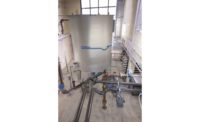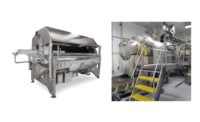One of the world’s largest dairy companies is installing a high efficiency wastewater treatment and water reuse facility at its new dairy plant in Jakarta to achieve 99 percent organic content removal to meet outstanding recycling and sustainability standards.
The new facility of PT Frisian Flag, a subsidiary of the Royal FrieslandCampina multinational, is scheduled for startup in 2022 and is using proven state-of-the-art technologies to produce potable recycled water from the plant wastewater.
The Global Water & Energy (GW&E) technologies employed include a COHRAL (Covered High Rate Anaerobic Lagoon) system of a type already proven in one of Australia’s largest meat processing facilities, at Oakey in Queensland, where it significantly improves water quality, reduces odor, while producing biogas to reduce fossil fuel demands and saving the company more than AUD $800,000 (approx. US $585,000) per year in natural gas.
The gas balloon, left, and the robust lagoon cover, right, under which anaerobic bacteria convert waste to biogas which is then stored in the balloon at the Oakey COHRAL installation, which is already functioning trouble-free, increasing water quality, and producing biogas
The Jakarta facility will not only achieve outstanding quality potable water outputs for recycling, but also the biogas generated there during treatment can later be used in the factory to decrease fossil fuel dependency. The plant is engineered to produce up to 6,000 Nm3 of biogas a day.
The facility will also benefit from minimal waste disposal costs, thanks to application of the anaerobic process and sludge dewatering units.
“The GWE technology employed here is a huge step into the future of sustainability and recycling for livestock industries and agribusiness producing waste with high organic content, says Michael Bambridge, managing director of CST Wastewater Solutions. Bambridge, whose company installed the GWE COHRAL plant at Oakey, says the technology being used in Indonesia is widely applicable to dairy and meat applications, including beef, lamb, pork, and poultry, throughout major livestock processor nations such as New Zealand, Australia and, increasingly, Southeast Asian nations striving for clean, green production facilities.
Major components of the GWE process employed at PT Frisian Flag include:
- Primary treatment by SUPERFLOT-AIR dissolved air flotation (DAF)
- Secondary treatment by COHRAL Covered High-Rate Anerobic Lagoon and AEROFIX Moving Bed Biofilm Reactor secondary treatment
- Mechanical sludge dewatering with volute-type screw press
- Odour control with vent air injection (in addition to odour control achieved by more the more compact COHRAL lagoons)
- Water reuse system including PURAQUA Disc filtration, Ultrafiltration, and Sanitary Reverse Osmosis
The compact GWE COHRAL plant involved in the Jakarta project typically occupies just half the footprint of comparable covered anaerobic lagoons. It is also far more efficient in breaking down organic content than general energy-hungry and odorous open aeration lagoons in service globally, says Bambridge.
Pre-treatment that is part of the GWE COHRAL process also leads also to better recoveries of valuable protein and fats which would normally end up in the wastewater. This provides a further gain to the bottom line as well as increasing reliability by isolating clogging waste from the high performance WWTP (Wastewater Treatment Plant), says Bambridge.
Source: PT Frisian Flag




Report Abusive Comment